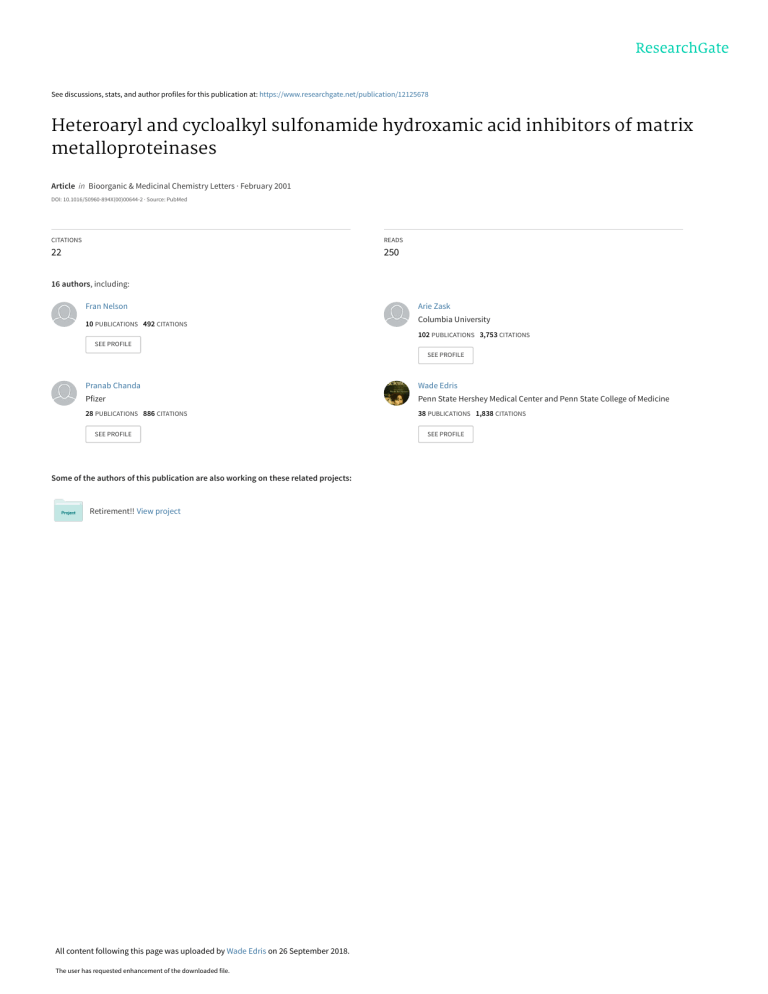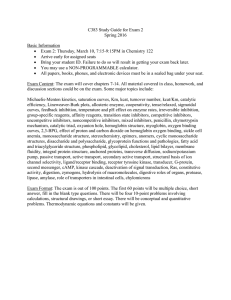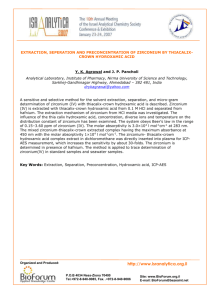
See discussions, stats, and author profiles for this publication at: https://www.researchgate.net/publication/12125678 Heteroaryl and cycloalkyl sulfonamide hydroxamic acid inhibitors of matrix metalloproteinases Article in Bioorganic & Medicinal Chemistry Letters · February 2001 DOI: 10.1016/S0960-894X(00)00644-2 · Source: PubMed CITATIONS READS 22 250 16 authors, including: Fran Nelson 10 PUBLICATIONS 492 CITATIONS Arie Zask Columbia University 102 PUBLICATIONS 3,753 CITATIONS SEE PROFILE SEE PROFILE Pranab Chanda Wade Edris Pfizer Penn State Hershey Medical Center and Penn State College of Medicine 28 PUBLICATIONS 886 CITATIONS 38 PUBLICATIONS 1,838 CITATIONS SEE PROFILE Some of the authors of this publication are also working on these related projects: Retirement!! View project All content following this page was uploaded by Wade Edris on 26 September 2018. The user has requested enhancement of the downloaded file. SEE PROFILE Bioorganic & Medicinal Chemistry Letters 11 (2001) 239±242 Heteroaryl and Cycloalkyl Sulfonamide Hydroxamic Acid Inhibitors of Matrix Metalloproteinases Jeremy I. Levin,a,* Yansong Gu,a Frances C. Nelson,a Arie Zask,a John F. DiJoseph,b Michele A. Sharr,b Amy Sung,b Guixian Jin,a Rebecca Cowling,a Pranab Chanda,b Scott Cosmi,c Chu-Lai Hsiao,c Wade Edris,c James Wilhelm,c Loran M. Killarb and Jerauld S. Skotnickia a Wyeth-Ayerst Research, 401 N. Middletown Road, Pearl River, NY 10965, USA b Wyeth-Ayerst Research, PO Box CN-8000, Princeton, NJ 08543, USA c Wyeth-Ayerst Research, Cambridge, MA 02140, USA Received 7 September 2000; accepted 8 November 2000 AbstractÐHeteroaryl and cycloalkyl sulfonamide-hydroxamic acid MMP inhibitors were investigated. Of these, the pyridyl analogue 2 is the most potent and selective inhibitor of MMP-9 and MMP-13 in vitro. # 2001 Elsevier Science Ltd. All rights reserved. The normal remodeling of extracellular matrix proteins is controlled by a family of zinc-containing matrix metalloproteinases (MMPs). A variety of pathologies such as rheumatoid arthritis,1 osteoarthritis,1 and cancer2 have now been associated with the abnormal regulation of more than 20 dierent MMPs. The ability of small molecule inhibitors of various MMPs to eectively treat arthritis and cancer is now being studied in man. Four representative compounds to have reached clinical trials are shown in Figure 1. Marimastat and CG-S27023A are broad spectrum MMP inhibitors while Ro-32-3555 is selective for the collagenases and AG-3340 shows a preference for MMP-13 over MMP-1.3 We have recently reported a novel series of anthranilic acid-based MMP inhibitors of general structure 1, which diers from most other inhibitors in having a two carbon linker between the sulfonamide nitrogen and the zinc chelating hydroxamic acid (Fig. 2).4 Figure 2. Anthranilic acid-based MMP inhibitors. Figure 1. MMP inhibitors in clinical trials. *Corresponding author. Tel.: +1-845-732-3053; fax: +1-845-732-5561; e-mail: levinji@war.wyeth.com The SAR of the anthranilic acid MMP inhibitors had shown that the sulfonamide, hydroxamic acid, and a third substituent must be on adjacent carbons of the aromatic ring, as shown in Figure 2, to provide compounds with potent activity against MMP-1, MMP-9, and MMP-13.4 In an eort to assess the eect of heteroatom substitution, ring size, and saturation on the anthranilic acid portion of the molecule we targeted the pyridyl, thienyl, pyrazolyl and cycloalkyl analogues of the anthranilic acids. We now disclose several extensions of this series, demonstrating that the anthranilic acid phenyl ring can be replaced with heteroaryl groups as well as a simple cyclohexyl moiety. 0960-894X/01/$ - see front matter # 2001 Elsevier Science Ltd. All rights reserved. PII: S0960-894X(00)00644-2 240 J. I. Levin et al. / Bioorg. Med. Chem. Lett. 11 (2001) 239±242 Chemistry The pyridyl analogue 2, with the required substitution pattern, was synthesized in eight steps starting from 3-amino-2,6-dimethoxypyridine, as shown in Scheme 1.5 Thus, reaction of the aminopyridine 3 with BOC-anhydride provided the carbamate 4 in quantitative yield. Metalation of the pyridine ring ortho to the carbamate with n-butyllithium and TMEDA followed by the addition of methyl chloroformate then gave the methyl ester 5 in 34% yield.6 Removal of the BOC moiety was accomplished with p-toluenesulfonic acid and the resulting amine was converted into the p-methoxybenzene sulfonamide in 86% overall yield. The sulfonamide was subsequently alkylated with benzyl bromide and sodium hydride in quantitative yield to give 6. Hydrolysis of the methyl ester with lithium hydroxide followed by conversion into the corresponding acid chloride and reaction with hydroxylamine then gave the desired pyridine 2, an analogue of the anthranilic acid series. Scheme 2. (i) 4-MeOPhSO2Cl, TEA; (ii) BnBr, NaH; (iii) NaOH; (iv) (a) (COCl)2, DMF, (b) NH2OH. (R=Ph) and 11b (R=3-pyridyl) as before. Palladium(II) catalyzed coupling of bromothiophene 10a with TMSacetylene and subsequent desilylation gave 12, which was converted into hydroxamic acid 13 as before. Scheme 1. (i) BOC2O; (ii) (a) n-BuLi, TMEDA, (b) ClCO2Me; (iii) p-TsOH; (iv) 4-MeOPhSO2Cl, TEA; (v) BnBr, NaH; (vi) LiOH; (vii) (a) (COCl)2, DMF; (b) NH2OH. The thiophene and pyrazole heteroaryl analogues of the anthranilic acids were readily available from commercial starting materials as shown in Scheme 2. The appropriate thiophene and pyrazole amino-esters 7a±d were sulfonylated with p-methoxybenzenesulfonyl chloride and pyridine to give sulfonamides 8a±d. Alkylation of the sulfonamides proceeded with sodium hydride and benzyl bromide. Hydrolysis of the esters and conversion of the resulting carboxylic acids into the hydroxamic acids proceeded as before to give 9a±d. The bromo and alkynyl-substituted thiophenes were synthesized from sulfonamide 8a as shown in Scheme 3. The alkynes were targeted since they provided a readily accessible substituent roughly equivalent in size to the methyl group that had enhanced the activity of compound 9c. Bromination of 8a with N-bromosuccinimide in acetic acid provided the corresponding bromothiophene in 81% yield. Benzylation as before, or alkylation with potassium carbonate and 3-picolyl chloride, gave the esters 10a (R=Ph) and 10b (R=3-pyridyl). Esters 10a and 10b were then converted into hydroxamates 11a Scheme 3. (i) NBS, AcOH; (ii) BnBr, NaH or 3-PyCH2Cl, K2CO3; (iii) NaOH; (iv) (a) (COCl)2, DMF; (b) NH2OH; (v) (a) TMS-CCH, (PPh3)2PdCl2, CuI, (b) Bu4NF. The saturated analogues of the anthranilic acid MMP inhibitors were prepared as shown in Scheme 4. Thus, racemic trans- and cis-2-aminocyclohexane carboxylic acids, 14a and 14b respectively, were reacted with p-methoxybenzenesulfonyl chloride to give the analogous sulfonamide-carboxylic acids. The acids were then converted into the corresponding tert-butyl esters with N,N-dimethylformamide di-tert-butyl acetal in re¯uxing toluene. The NH-sulfonamides were alkylated with benzyl bromide and sodium hydride to give sulfonamideesters 15. The tert-butyl esters were next deprotected with tri¯uoroacetic acid to provide the carboxylic acids. Hydroxamic acid formation was accomplished as before with oxalyl chloride/DMF followed by the addition of hydroxylamine to give 16a (trans) and b (cis). J. I. Levin et al. / Bioorg. Med. Chem. Lett. 11 (2001) 239±242 Scheme 4. (i) 4-MeOPhSO2Cl, TEA; (ii) (Me)2NCH(OtBu)2; (iii) BnBr, NaH; (iv) TFA; (v) (a) (COCl)2, DMF, (b) NH2OH. Biology All of the hydroxamic acid ®nal products were tested in vitro7,8 for their ability to inhibit MMP-9. Inhibitors of MMP-9 are postulated to have utility as inhibitors of tumor metastasis. Most compounds were also tested against the collagenases MMP-1 and MMP-13, which are presumed to be important in the etiology of osteoarthritis. The in vitro potencies of these compounds are shown in Table 1. Pyridine analogue 2 is a potent inhibitor of both MMP-9 and MMP-13 with moderate selectivity over MMP-1. Compounds with this selectivity pro®le may be useful in assessing the basis of musculoskeletal side eects seen in clinical trials of some MMP inhibitors.9 Pyridine 2 is almost 3-fold more potent against MMP-13 than the corresponding 3-methoxy anthranilic acid analogue (1b, Table 1), and much more selective over MMP-1. The reason for this apparent increase in potency is not known. Compound 2 is also a moderately potent inhibitor of TNF-a converting enzyme (TACE), with an IC50 of 294 nM.10 Unfortunately, compound 2 was not orally active against MMP-13 at a dose of 50 mg/kg in the rat dialysis implant bioactivity model.11 The thiophene derivatives 9a and 9b, lacking a second substituent adjacent to the sulfonamide nitrogen were very weakly active versus MMP-9 in accord with the SAR previously shown for the anthranilic acid derivatives. As expected, incorporation of a methyl substituent next to the sulfonamide nitrogen in thiophene 9c provides 241 approximately a 100-fold increase in potency against MMP-9. The two bromothiophenes, 11a and 11b, were both moderately potent versus MMP-9. As in the anthranilic acid series, the N-picolyl sulfonamide is somewhat more active than the N-benzyl derivative. The alkynyl substituent of thiophene 13 is less eective at increasing potency, perhaps due to its smaller steric bulk. None of the thiophene hydroxamic acids approached the level of MMP inhibition achieved by the anthranilic acid hydroxamic acids (see 1a, Table 1). The picolyl derivative 11b was inactive on oral dosing at 100 mg/kg against MMP-9 in the rat dialysis implant bioactivity model. The pyrazole analogue 9d was only weakly active against MMP-9 even with the methyl group on the pyrazole nitrogen acting as the requisite second substituent adjacent to the sulfonamide nitrogen. The electron de®cient nature of the pyrazole ring may be responsible for the diminished in vitro activity of 9d relative to the electron rich thiophenes. The cyclohexyl analogues 16a and 16b are also less active than the anthranilic acid hydroxamic acids 1a and 1b versus both MMP-9 and MMP-13. The trans-cyclohexyl derivative is more potent than the cis-isomer against MMP-1, MMP-9, and MMP-13. The level of activity for the trans-cyclohexyl analogue, 16a, is somewhat high, however, in light of the fact that the corresponding anthranilic acid analogue lacking a 3-substituent (1, R1=Bn, R2=H) is a 555 nM inhibitor of MMP-13. In conclusion, we have investigated the pyridyl, thiophene, pyrazole and cyclohexyl analogues of the anthranilate hydroxamate class of MMP inhibitors. The pyridyl derivative 2 is more potent and selective in vitro than the related anthranilate 1b. The thiophene and pyrazole rings proved to be less satisfactory replacements for the phenyl ring of the anthranilate hydroxamic acids. It is unclear whether the decrease in potency observed for these two scaolds is due to electronic or steric eects. The cyclohexyl ring is also a less eective scaold for the sulfonamide-hydroxamate pharmacophore, although incorporating additional substituents on the cycloalkyl ring might provide more active compounds. Two of the compounds (2 and 11b) were tested in vivo and were inactive at the dose tested. Table 1. In vitro potency of sulfonamide-hydroxamic acids Compound MMP-1a MMP-9a MMP-13a 1a (R1=CH2-3-Py, R2=Me) 1b (R1=CH2Ph, R2=OMe) 2 9a 9b 9c 9d 11a 11b 13 16a 16b 143 520 1227 40% (1)b 19% (1)b NT 22% (1)b 639 50% (1)b 49% (1)b 174 361 5 23 15 67% (10)b 57% (10)b 104 900 236 70 38% (0.3)b 181 318 8 138 47 NTc NT NT NT 427 290 35% (0.3)b 233 291 a IC50 (nM). % Inhibition (mM). c NT=not tested. b References and Notes 1. (a) Clark, I. M.; Rowan, A. D.; Cawston, T. E. Curr. Opin. Anti-In¯ammat. Immunomodulat. Investigat. Drugs 2000, 2, 16. (b) Shaw, T.; Nixon, J. S.; Bottomley, K. M. Exp. Opin. Invest. Drugs 2000, 9, 1469. (c) Bottomley, K. M.; Johnson, W. H.; Walter, D. S. J. Enzyme Inhib. 1998, 13, 79. 2. (a) Yip, D.; Ahmad, A.; Karapetis, C. S.; Hawkins, C. A.; Harper, P. G. Investigat. New Drugs 1999, 17, 387. (b) Nelson, A. R.; Fingleton, B.; Rothenberg, M. L.; Matrisian, L. M. J. Clin. Oncol. 2000, 18, 1135. 3. (a) For recent comprehensive reviews, see: Montana, J.; Baxter, A. Curr. Opin. Drug Disc. Devel. 2000, 3, 353. (b) Whittaker, M.; Floyd, C. D.; Brown, P.; Gearing, A. J. H. Chem. Rev. 1999, 99, 2735. (c) Beckett, R. P.; Whittaker, M. 242 J. I. Levin et al. / Bioorg. Med. Chem. Lett. 11 (2001) 239±242 Exp. Opin. Ther. Patents 1998, 8, 259. (d) Zask, A.; Levin, J. I.; Killar, L. M.; Skotnicki, J. S. Curr. Pharm. Des. 1996, 2, 624. 4. Levin, J. I.; Du, M. T.; DiJoseph, J. F.; Killar, L. M.; Sung, A.; Walter, T.; Sharr, M. A.; Roth, C. E.; Moy, F. J.; Powers, R.; Skotnicki, J. S. Bioorg. Med. Chem. Lett. 2001, 11, 235. 5. All new compounds gave satisfactory 1H NMR, IR, and MS data in accord with the assigned structure. 6. Rewcastle, G. W.; Denny, W. A.; Winters, R. T.; Colbry, N. L.; Showwalter, H. D. H. J. Chem. Soc., Perkin Trans. 1 1996, 2221. View publication stats 7. Weingarten, H.; Feder, J. Anal. Biochem. 1985, 147, 437. 8. Inhibitor concentrations were run in triplicate and IC50 determinations were calculated from a four-parameter logistic ®t of the data within a single experiment. 9. Scrip. 1998, 2349, 20. 10. Jin, G.; Black, R.; Wolfson, M.; Rauch, C.; Ellestad, G. A.; Cowling, R. Manuscript in preparation. 11. DiJoseph, J. F.; Sharr, M. A. Drug Dev. Res. 1998, 43, 200.

